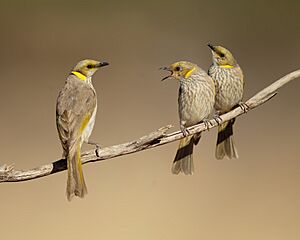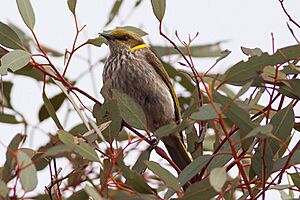Yellow-plumed honeyeater facts for kids
Quick facts for kids Yellow-plumed honeyeater |
|
|---|---|
 |
|
| Conservation status | |
| Scientific classification | |
| Genus: |
Ptilotula
|
| Species: |
ornata
|
| Synonyms | |
|
Lichenostomus ornatus |
|
The yellow-plumed honeyeater (Ptilotula ornata) is a type of bird from the Meliphagidae family, also known as honeyeaters. This bird lives only in Australia, which means it is endemic there. You can find it in temperate forests and areas with Mediterranean-style shrubs.
This honeyeater used to be in a different group called Lichenostomus. But scientists studied its DNA in 2011. They found it fit better into the Ptilotula group. This new grouping helps us understand bird families better.
Contents
About the Yellow-Plumed Honeyeater
The yellow-plumed honeyeater is a medium-sized bird. It has a black beak that curves downwards. Its face is dark, and it has a special bright yellow feather plume on its neck that sweeps upwards.
Its head is olive-green, with a light yellow line under its dark eye. The top part of its body is grey-green. Its belly is grey-brown with many streaks. Young birds have a yellow base on their beak and a yellow ring around their eyes.
Other birds that look similar include the purple-gaped honeyeater, grey-fronted honeyeater, and fuscous honeyeater.
What Does It Sound Like?
This bird has a loud and clear song. It sounds like "chier wit chier" repeated three times. They often sing before the sun comes up. Males also sing this song when they are flying to show off.
Where Do They Live?
The yellow-plumed honeyeater lives only in southern mainland Australia. You can find them from western New South Wales and Victoria. Their range extends through South Australia to the southwest of Western Australia.
Life in Their Habitat
These birds mostly live in mallee areas. Mallee is a type of Australian bushland with many small eucalyptus trees. In the western part of Australia, they live in more places. This includes dry eucalyptus woodlands and open eucalyptus forests.
Sometimes, they visit other areas. They might be seen in Acacia and Callitris woodlands. During certain seasons, they visit flowering red ironbark forests. They also go to flowering grey box and yellow box woodlands.
Yellow-plumed honeyeaters live in groups and stay in one area. However, if conditions get tough, they might move to a new place. They are known for being noisy and easy to spot. Groups of these birds will work together to protect their nesting or feeding areas. They do this by shaking their wings together.
What Do They Eat?
Yellow-plumed honeyeaters mainly eat insects. They actively search for food in the outer leaves, upper branches, and trunks of eucalyptus trees. They also catch insects while flying, a method called hawking.
Sometimes, they also drink nectar from flowers. They get nectar from various mallee eucalyptus trees. They also like nectar from yellow gum, grey box, red ironbark, and box mistletoe.
Reproduction and Nests
Yellow-plumed honeyeaters build open, cup-shaped nests. They hang their nests from leaves or thin branches of mallee eucalyptus trees and other small shrubs. They make their nests from wool, green grass, and spider webs. The inside of the nest is soft, lined with wool, grasses, plant-down, and bright feathers.
Both parent birds help feed their young. Sometimes, other birds, called "helpers," also assist with feeding the baby birds.
Sadly, other birds sometimes lay their eggs in the honeyeater's nest. This is called brood parasitism. Birds like fan-tailed cuckoos, pallid cuckoos, Horsfield's bronze-cuckoos, and shining bronze-cuckoos do this.
Protecting the Yellow-Plumed Honeyeater
Conservation Status
The yellow-plumed honeyeater is listed as a species of Least Concern by the IUCN Red List of Threatened Species. This means it is not currently at high risk of disappearing.
Protected Areas
This bird lives in several protected areas. These places help keep their habitats safe. Some of these areas include:
- New South Wales
- * Pulletop Nature Reserve
- South Australia
- * Gluepot Reserve
- Victoria
- * Greater Bendigo National Park
- * Inglewood Nature Conservation Reserve
- * Wychitella Nature Conservation Reserve



